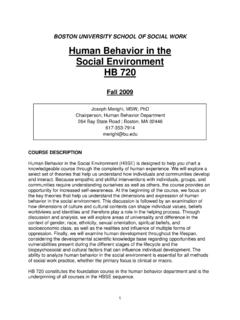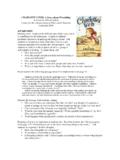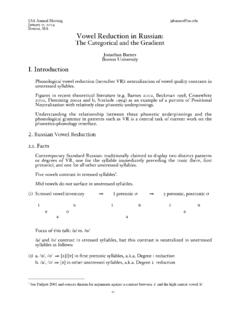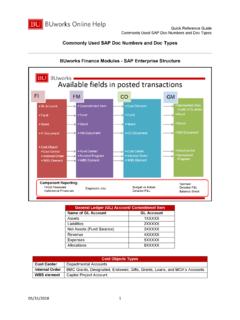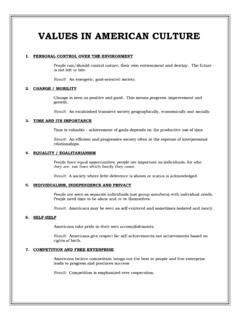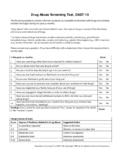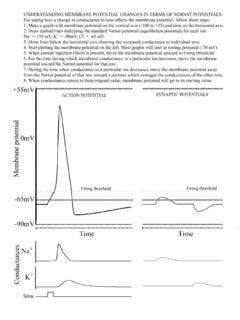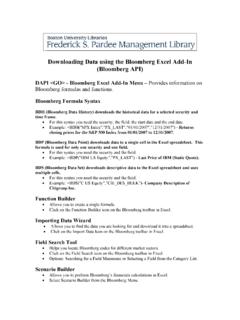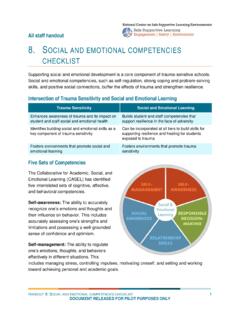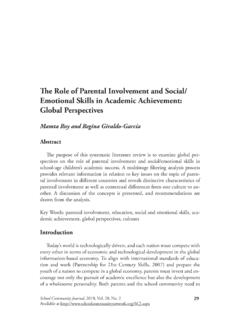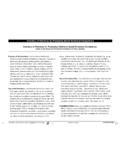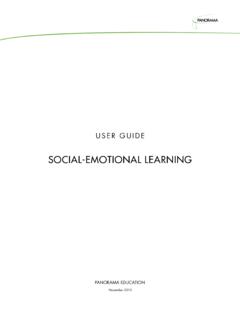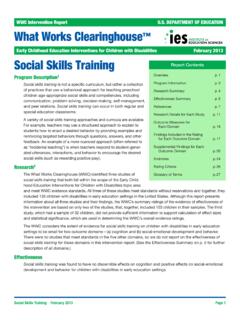Transcription of Social Work Competencies and Multidimensional Assessment
1 PerspectivesSocial Work Competencies and Multidimensional AssessmentJOHN POULINSELINA MATISThe authors review the Council on Social Work Education s 2015 Educational Policyand Accreditation Standards (EPAS) related to the Assessment of Social workcompetencies. The 2015 EPAS focuses on the Multidimensional Assessment of holisticcompetencies (Drisko, 2015). This is a significant change from the Assessment ofpractice behaviors approach of the 2008 EPAS. This article aims to clarify the intentionand language related to Assessment in the 2015 EPAS and to provide programs with anoverview of possible ways of developing Assessment plans that are in compliance withAccreditation Standard Assessment . KEYWORDS accreditation, Assessment , best practices, Social work Competencies What is the goal of higher education?
2 This is a complex question that requiresan equally complex answer. Boahin and Hofman (2012) suggest that the maingoal of education is to prepare an individual for life which involves a multipleof roles in order to function effectively in one s community (p. 285). Relatedto preparedness, it is necessary for learners to gain knowledge and skills; thisobtainment of knowledge and skills is considered competence. Undoubtedly,achieving competence is a cornerstone in the pursuit of higher education andthe preparation for professional article reviews competency- based Social work education and themultidimensional Assessment of Social work Competencies by baccalaureatesocial work educational programs. Competency- Based EducationCompetenceis both a professional and pedestrian term. According to Drisko(2014), competence refers to the ability of an individual to perform a task, further adding that the task must be performed fully and properly (p.)
3 416).McKnight (2013) proposes that competence is an ongoing ability to integrate knowledge, skills, judgment, and professional attributes in order topractice safely and ethically within one s professional scope (p. 460). Simply,competence refers to the ability of the individual to complete tasks related to real- life situations within his or her profession (Blomeke, Gustafsson, &Shavelson, 2015). The Journal of Baccalaureate Social Work, Vol. 20 (2015) 2015 by the Association of Baccalaureate Social Work Program Directors. All rights Fri/December/4/2015 Fri/Dec/4/2015/ 11:18 AM Page 117 JOURNAL OF BACCALAUREATE Social WORK118 Competence assessments are a growing norm in higher education (Rissi &Gelmon, 2014). Competency- based assessments focus on the result of theeducational process (Kiguli- Malwadde et al.
4 , 2014). A goal of competence- based assessments is to provide learners with relevant skills and knowledge inorder to best prepare them for their professional futures (Maxwell, 2012).Theeb, Muhaidat, and Al- Zboon (2014, p. 133) consider competency- basededucational programs to be an institutional process that has produced ashift in focus from what teachers think is important (teacher based) to focuson what students need to know and be able to perform (based on thestudent/workplace), as well as considering skills associated with vocationalneeds identified by employers and specialists. Schuwirth and Ash (2013, p. 555) submit that this form of outcome- basededucation is conquering the world and is the most prevalent frameworkwithin curricula of the health professions. Despite the burgeoning focus oncompetence in higher education, there remains some challenges related tothis approach.
5 Rissi and Gelmon (2014, p. 336) see these as identifyingappropriate Competencies .. and assessing the development of studentcompetence along with more specific concerns such as the relationshipsamong competence, program curricula, and course content ..; course- levelteaching, learning, and Assessment methods ..; and the validity, relevance,and balance among Competencies . AccreditationAccreditation is a process of external quality review created and used byhigher education (Eaton, 2011, p. 1). Moskal, Ellis, and Keon (2008) set forththat accreditation serves to encourage continuous quality improvementthrough Assessment (p. 269). For Social work education programs in theUnited States, the accrediting body is the Commission on Accreditation (COA)of the Council on Social Work Education (CSWE). CSWE s Commission onEducational Policy (COEP) creates educational policy for Social workeducation, and COA creates accreditation standards.
6 The educational policyand accreditation standards together form the Educational Policy andAccreditation Standards (EPAS), the guide to the accreditation ofbaccalaureate- and master- s- level Social work educational programs. The2015 EPAS focus on holistic competence (Drisko, 2015). Social work competence is the ability to integrate and apply Social workknowledge, values, and skills to practice situations in a purposeful,intentional, and professional manner to promote human and community well- being. EPAS recognizes a holistic view of competence; that is, theJBSW-2015-Poulin-2f_JBSW Fri/December/4/2015 Fri/Dec/4/2015/ 11:18 AM Page 118demonstration of competence is informed by knowledge, values, skills, andcognitive and affective processesthat include the Social worker s critical thinking,affective reactions, and exercise of judgment in regard to unique practicesituations.
7 (CSWE, 2015, p. 6, emphasis added) Social Work CompetenciesThe 2015 EPAS identify nine Social work Competencies : (1) demonstrateethical and professional behavior; (2) engage diversity and difference inpractice; (3) advance human rights and Social , economic, and environmentaljustice; (4) engage in practice- informed research and research- informedpractice; (5) engage in policy practice; (6) engage with individuals, families,groups, organizations, and communities; (7) assess individuals, families,groups, organizations, and communities; (8) intervene with individuals,families, groups, organizations, and communities; and (9) evaluate practicewith individuals, families, groups, organizations, and communities. The 2015 EPAS provide a description of each competency that defines the CompetenciesThe nine Social work Competencies mandated by CSWE are connected andinterrelated components of professional Social work practice.
8 Therelationships among the Competencies are bidirectional and circular. Therelationships are not hierarchical or linear. Figure 1 shows a conceptualizationof the interrelationships among the nine professional Social workcompetencies. The Competencies in the outer ring are those that applybroadly to all practice situations. Ethical behavior, diversity, and Social justicecompetency are fundamental components of effective Social work Competencies in the middle ring of the figure are the two areas ofsocial work practice that are not client- based. Policy practice and researchcompetence are informed by the Competencies of diversity, Social justice, andethical behavior and in turn inform Social work practice with clients andconstituencies. The Competencies in the inner circle are those related tosocial work practice with individuals, families, groups, organizations, andcommunities.
9 Diversity, Social justice, ethical behavior, policy practice, andresearch competency all inform the practice Competencies of engagement, Assessment , intervention, and evaluation with different clients 2015 EPAS identifies six dimensions that are associated with eachsocial work competency performance, knowledge, values, affectivereactions, critical thinking, and professional judgment. Performanceis theSOCIAL WORK Competencies AND Multidimensional ASSESSMENT119 JBSW-2015-Poulin-2f_JBSW Fri/December/4/2015 Fri/Dec/4/2015/ 11:18 AM Page 119behavioral dimension of the competency, and knowledgeis the cognitivedimension. The performance dimension is best measured by observation andthe knowledge dimension by examinations or course valuesdimension is less clear. It can have knowledge and/orperformance components.
10 Students knowledge of Social work values relatedto each competency could be assessed as well as their ability to make ethicaldecisions in practice. The values dimension is a component of eachcompetency that can be measured in terms of performance (ethical behaviorand decision making) or knowledge ( Social work values).Affective reactions generally refer to the affective component of practice withclients (Rubaltelli & Slovic, 2008). It is the worker s emotional response to theclient and his/her situation, which is tied to empathy and other affectiveprocesses. Affective reactions have relevance for Social work competency inthat effective Social work practice requires cognitive and affectiveunderstanding of the client as well as one s own feelings, emotions, andreactions. It is an internal process that cannot be directly observed.
